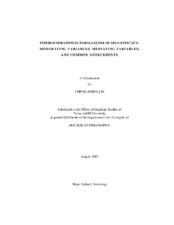| dc.description.abstract | A number of theories and studies in sociology and psychology have asserted that self-efficacy is both the consequence and cause of our everyday life experiences. However, there is little empirical evidence to support the existence of intergenerational parallelism of self-efficacy between generations. And if it exists, then the processes by which self-efficacy is transmitted from parents to children is rarely documented in the literature. In addition, it is noteworthy to examine whether such intergenerational transmission of self-efficacy exists among different types of families, genders, or racial groups. In my dissertation, I intend to answer these inquiries by utilizing a longitudinal data set that incorporates information of three generations (grandparents, parents, and grandchildren) reporting their individual age, educational attainment, self-esteem, and self-efficacy, with both parent generation's self-efficacy and child generation's self-efficacy having been collected in the same developmental stage (early adolescence). In addition, parents also reported several aspects of their adulthood conditions and behaviors, including their occupation, substance use, parenting behaviors, educational expectation upon their children, and their self-efficacy in adulthood, which I introduce as mediating mechanisms of the intergenerational transmission of self-efficacy. Finally, I analyzed this model separately in terms of family structure (dual- or single-parent families), child's gender, parent-child gender dyads, and race/ethnicity.
The results suggest that there exists intergenerational parallelism of self-efficacy, and parent generation's self-efficacy (in adolescence) is associated with parents' choices of conventional pathways towards adulthood. These conventional pathways that self-efficacious parents choose in turn exhibit a strong influence on the development of the child's self-efficacy. These findings are independent of other influences, e.g. the family's social economic status, race/ethnicity, ages of both generations, and family structure. The implications and contributions of this research are discussed in the last chapter. | en |


